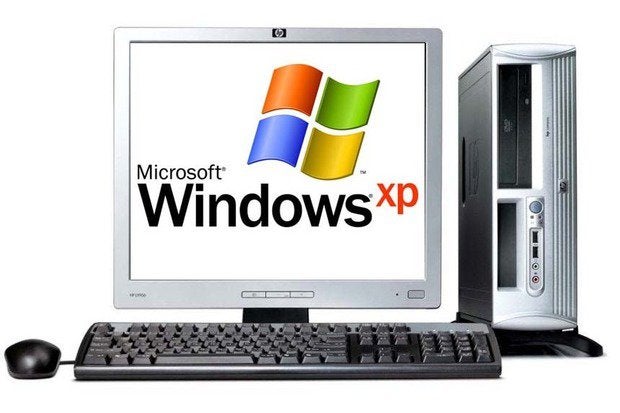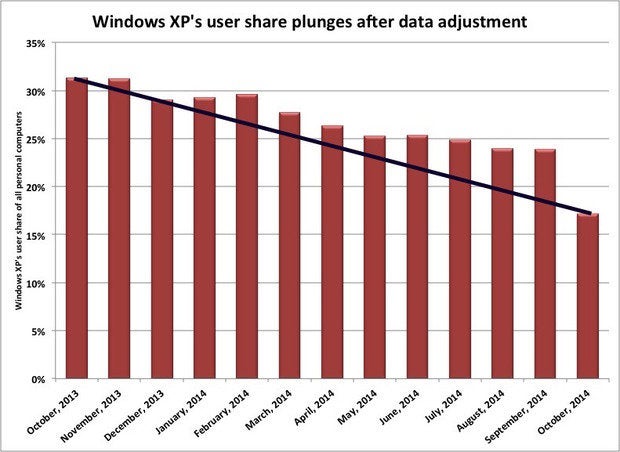Windows XP's user share plunge not real, just a data adjus
Source: Gregg Keizer
 The Internet metrics company that claimed Windows XP's user share plummeted by a record amount last month said Tuesday that it had struck several Chinese websites from its tallies, causing the dramatic decline.
The Internet metrics company that claimed Windows XP's user share plummeted by a record amount last month said Tuesday that it had struck several Chinese websites from its tallies, causing the dramatic decline.
Net Applications argued that its estimates are now "more accurate."
The California company's data, which is widely used by the media to track the ups and downs of browsers and operating systems, had reported October's numbers on Saturday. According to its estimates, Windows XP's user share had plunged a record 6.7 percentage points last month, while Windows 8 had soared by 4.5 points, also a record.
On Monday, the firm acknowledged a problem with the data. "We are still researching, but it does appear to be an anomaly," said Vince Vizzaccaro, head of marketing for Net Applications, in an email reply to questions over the weekend about the validity of the Windows XP and Windows 8 changes.
On Tuesday, Net Applications explained why Windows' XP's user share had fallen off the proverbial cliff.
"This drop was primarily caused by a major change in the network of sites we have in China," the company said in a statement. "A group of large Chinese publishers with a very large number of visitors per day had audiences heavily skewed towards Windows XP (nearly 100% XP). In researching the nature of the sites, we determined they were not appropriate for our network. We removed those publishers ourselves, which caused the shift since Chinese traffic is weighted higher due to lower coverage."
Net Applications weights website visitor tallies by country using estimates of each nation's online population, a way to account for markets where it has little actual data, and balance those against countries where it has considerable amounts of information. Because Net Applications collects significantly less data from China, for example, than it does from the U.S., each visitor from China is "worth" more to the result than one from the United States.
Net Applications did not say why the sites it yanked were suddenly "not appropriate" after they had been used to calculate user share previously. And in a follow-up email, Vizzaccaro declined to describe or name the Chinese sites that affected the data. However, he did say that Net Applications drops sites for several reasons, including "gaming" its analytics and receiving traffic from bots, browser toolbars or other automated page-view generators.
The company argued that by scrubbing out the Chinese websites' tallies, the result is a better picture of the percentages of the world's personal computers that run Windows XP and other operating systems. "The current data set is more accurate than in the past due to this," Net Applications said.
Assuming that Net Applications is right -- which outsiders might find hard to swallow -- the data showing a record fall of Windows XP, and for that matter the record increase of Windows 8, were in reality adjustments, not one-month real-world changes. In other words, Windows XP had been declining at a more rapid pace all along, while Windows 8 had been increasing faster than Net Applications had measured previously.
"Unfortunately, we can't go back and apply this change to historical data," said Vizzaccaro.
The one-off decline of Windows XP's user share also impacted other operating systems. Because Net Applications reports user shares as percentages of a whole, a drop in XP would require a corresponding increase elsewhere. That may have been the cause of the dramatic October boost to Windows 8's user share as it, too, was readjusted. It also meant that other OSes, such as Windows 7 and Apple's OS X, may have been under-reported previously.
There are oddities that remain in Net Applications' data, however, even after the company's explanation. For October, the firm pegged the user share of Windows NT at 1.64%, an inexplicable increase from 0.05% of September. Windows NT, a precursor to Windows 95, was first released in 1993.

Windows XP share adjustment Data: Net Applications
If Windows XP had declined linearly the portions above the black line would represent the errors in its user share over the last year.
| }
|